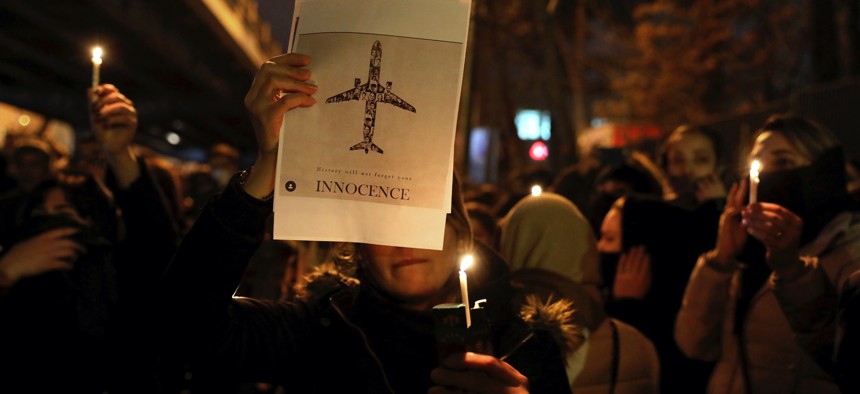
People gather for a candlelight vigil to remember the victims of the Ukraine plane crash, at the gate of Amri Kabir University that some of the victims of the crash were former students of, in Tehran, Iran, Saturday, Jan. 11, 2020. AP / Ebrahim Noroozi
The Downed Jetliner Reminds Us that War Spins Out of Control
Mistakes and misperceptions bookended this latest episode in the long conflict between the U.S. and Iran. Expect that not to change.
The downing of Ukraine International Airlines Flight 752 and the deaths of all 176 people on board—newlyweds flying home from their wedding, graduate students charting ambitious careers, whole families returning from visiting relatives—have come to be portrayed as a tragic asterisk tacked onto the dramatic tale of how Donald Trump and Iranian Supreme Leader Ayatollah Ali Khamenei nearly went to war in the early days of 2020.
Over the weekend, for example, The New York Times published a comprehensive and vivid account of the week-long U.S.-Iran showdown. While the article ran more than 6,500 words, it included only one sentence on the plane crash. “In the confusion, a Ukrainian civilian passenger jet was destroyed by an Iranian missile,” the reporters wrote.
Trump, meanwhile, has claimed vindication for his handling of the crisis with Iran, but has barely mentioned the demise of Flight 752, other than to speculate about what caused the aircraft to explode. He has tweeted often (including in Farsi) about the anti-government protests currently roiling Iran without referencing the impetus for them: the Iranian military accidentally shooting down the airplane, whose passengers were mostly Iranian nationals, and the country’s leaders then lying to their own people and the world about it for days.
But the shoot-down isn’t just some side event in the latest chapter of this story. It is the story, just as much as the U.S. and Iranian governments deciding to de-escalate hostilities is. The incident is a glaring example of how the months-long tit for tat between the two countries—which is far from over, even though their confrontation is for the moment less violent—can spiral out of control even when neither side wants it to. And it should serve as a counterweight to any notion that the parties have full command over the struggle they’ve been stepping up ever since the Trump administration withdrew the United States from the Iran nuclear deal in 2018.
Related: Iran Is Expanding Its Online Disinformation Operations
Related: Iran Is Getting Ready to Blow Up A Fake Aircraft Carrier, Again
Related: On Iran, It's Time to Return to Containment
It’s revealing that the most recent round of hostilities between the countries was bookended by mistakes and misperceptions. The Times reported that the triggering event—a rocket attack by an Iranian-backed militia in late December that killed an American contractor at an Iraqi military base—was intended to exert pressure on the United States but not escalate the conflict, according to U.S. intelligence assessments. “The rockets landed in a place and at a time when American and Iraqi personnel normally were not there and it was only by unlucky chance that [the contractor] was killed,” the paper noted.
Whatever Iran’s intention, the attack did indeed leave an American dead. Which prompted the Trump administration to kill dozens of militia members in retaliatory strikes. Which led to supporters of that militia storming the U.S. embassy in Baghdad. Which resulted in Trump ordering the targeted killing of the Iranian general Qassem Soleimani in Iraq. Which moved Iran to fire missiles at Iraqi military bases hosting U.S. forces. Which caused the Iranians to brace for blowback from the United States, creating the conditions in which an Islamic Revolutionary Guard Corps missile operator apparently mistook Flight 752 for an American cruise missile and, with 10 seconds to act and his communication channels malfunctioning, blasted it out of the sky above Tehran.
Iran seemed to carefully calibrate its missile barrage on Iraqi bases—which damaged U.S. military airfields, blast walls, and various facilities but inflicted no casualties—to symbolically avenge Soleimani’s death without dramatically ramping up its fight with the United States. And the Trump administration chose to respond with similar restraint, asserting that the Iranians were “standing down” and that Washington effectively would as well, by limiting its retaliation to additional economic sanctions. The two foes even exchanged de-escalatory messages over encrypted fax via the Swiss embassy in Tehran. But if one needed an illustration of the difference between intentionally escalating hostilities during a crisis and unintentionally doing so, there’s no starker one than the Iranian military (more or less) precisely firing missiles at specific U.S. military targets and then, hours later, accidentally launching a missile that obliterated a plane with Iranian citizens on board.
The downing of Flight 752 “shows how even restrained retaliation could quickly turn into inadvertent escalation” and how actors in international crises are often less capable than their adversaries assume they are, especially when they’re in a defensive crouch, Jacquelyn Schneider, a national-security expert at Stanford University’s Hoover Institution, wrote on Twitter. (In this case, the incompetence of the Iranian military has been particularly noteworthy.) And while Iran and the United States are likely to proceed cautiously with their deliberate escalation—Iranian leaders know that they would lose a direct conventional war with the U.S., and Trump doesn’t want to get sucked into another protracted conflict in the Middle East—the biggest risk in ongoing tensions is inadvertent escalation, Schneider argued: “More mistakes will be made.”
Yes, the parties seem to have looked war in the face and recoiled, but they may simply be channeling their escalation in new directions rather than truly de-escalating. As the Trump administration heaps economic pressure on Iran and shines a spotlight on anti-government demonstrations there, and as Iran’s leaders grapple with this serious internal challenge to their rule and act out further by, say, launching cyber attacks, mobilizing proxy forces, or backing out of their commitments under the nuclear deal, the conflict could spin out of control again.
To confidently conclude that escalation is a manageable force would be reckless. Imagine, for instance, that those Iranian missiles had killed Americans, something Trump has deemed unacceptable and threatened to counter with overwhelming force. Troops at one of the Iraqi bases that came under assault told Reuters that a soldier came “very close to being blown up inside a shelter behind the blast walls.” And Lieutenant Colonel Staci Coleman, the U.S. Air Force officer who runs the airfield there, told The Wall Street Journal that she thought the Iranians “really wanted to target our [air] assets and if they so happened to kill Americans in the process, that was okay with them.” Or imagine if Americans had been on board Flight 752. How would the world look today? To channel Leon Trotsky, you may not be interested in escalation, but sometimes escalation is interested in you. It’s a fallacy to presume that state actors can completely control a crisis. After all, who would have predicted that Iranians would be in the streets this week calling for the downfall of the supreme leader as Trump cheers them on?
“Most obviously, humility is in order,” Robert Jervis, an international-relations theorist at Columbia University, wrote recently, regarding the lessons of the U.S. standoff with Iran. “My guess is that neither President Donald Trump nor the Iranians know what they will do next (and what they think they will do may be different from what they will do when the time comes).” Next time—and there will be a next time—the Swiss and their encrypted fax machine may not be sufficient to avert a war no one wants.




